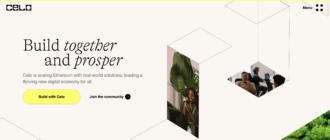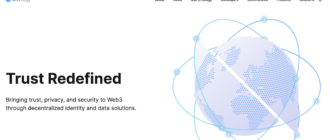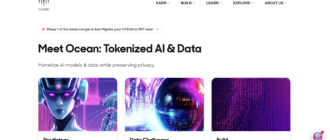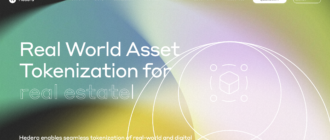This article delves into the Render Network and its native cryptocurrency, RNDR. We will explore the origins of the Render project, its technological framework, and the innovative tokenomics driving its ecosystem. Additionally, we will analyze the growth prospects and future developments anticipated for Render and RNDR. By the end, readers will have a comprehensive understanding of how Render Network is revolutionizing GPU rendering and contributing to advancements in fields like media production and artificial intelligence.
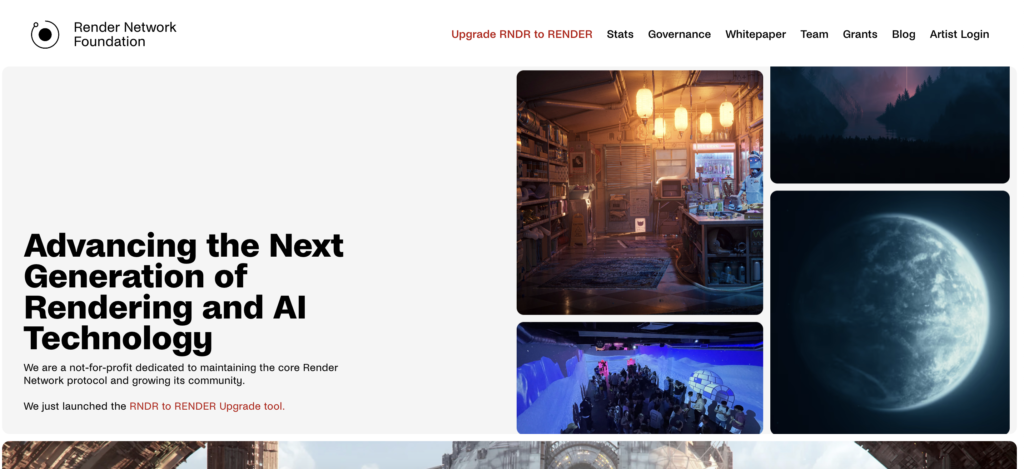
What is Render Network?
Render Network (RNDR) is a decentralized platform designed to connect creators in need of high-performance GPU rendering power with providers who have idle GPU resources. This peer-to-peer network leverages blockchain technology to facilitate a distributed supercomputing environment, enabling the efficient execution of complex rendering tasks. By tapping into the underutilized GPU capacities of its network participants, Render Network aims to offer scalable, cost-effective, and high-quality rendering services for a variety of applications, including visual effects, gaming, virtual and augmented reality, and artificial intelligence.
The core mission of Render Network is to democratize access to powerful rendering tools, thus allowing artists, developers, and researchers to bring their creative and computational projects to life without the prohibitive costs associated with traditional rendering farms. The platform’s native cryptocurrency, RNDR, serves as the primary medium of exchange, ensuring seamless transactions and incentivizing GPU providers to contribute their resources.
History of Render Network
Render Network was founded to address the increasing demand for GPU computing power, particularly in the fields of media production and artificial intelligence. The project was initiated by a team of experienced professionals in the 3D graphics and blockchain sectors. Key milestones in the development of Render Network include:
- 2017: The concept of Render Network was introduced, and the initial development phase began, focusing on building the foundational technology and infrastructure.
- 2018: Early testing phases commenced, allowing select users to participate in pilot projects and provide feedback to refine the platform.
- 2019: The Render Network officially launched its beta version, opening the platform to a broader user base and enabling the first large-scale rendering projects to be executed on the network.
- 2020: Significant enhancements were made to the network’s capabilities, including the integration of advanced matchmaking algorithms and dynamic pricing models to optimize resource allocation and cost efficiency.
- 2021: Render Network expanded its ecosystem by forming strategic partnerships with industry leaders in media and technology, further validating its utility and driving adoption.
- 2022: The platform saw increased usage in AI and machine learning applications, positioning itself as a crucial resource for computationally intensive tasks.
- 2023: Continuous improvements and scaling efforts were implemented to support the growing demand, with the introduction of new features aimed at enhancing the user experience and network performance.
Throughout its development, Render Network has remained committed to leveraging blockchain technology to provide a decentralized and secure environment for GPU rendering, thereby revolutionizing the way digital content is created and processed.
How Does Render Network Work?
Render Network leverages a decentralized, blockchain-based infrastructure to connect creators needing GPU rendering power with providers offering idle GPU resources. The platform utilizes advanced technologies to optimize the rendering process, ensuring efficiency, cost-effectiveness, and high-quality outputs.
Key Technologies and Their Roles
Ethereum Blockchain: Render Network operates on the Ethereum blockchain, utilizing its robust and secure infrastructure to manage transactions and maintain a trustless environment. The use of Ethereum ensures high liquidity and interoperability with other ERC-20 tokens, making it easy for users to convert RNDR tokens to ETH and other cryptocurrencies.
ORBX Format: The ORBX file format, developed by OTOY, plays a crucial role in the Render Network. It is an open-source format designed to encode all elements of a 3D scene, allowing for seamless transfer and rendering across different platforms. This enables efficient distribution of rendering tasks among multiple GPU providers.
Proof of Render: This consensus mechanism ensures the accuracy and completeness of rendered outputs. Similar to traditional blockchain consensus algorithms, Proof of Render verifies the work completed by GPU providers, maintaining the integrity of the rendering process and safeguarding against malicious activities.
Rendering Process
- Job Submission: Creators submit rendering jobs to the network, specifying the required data and job specifications. These jobs can range from complex 3D scenes to high-resolution videos and simulations.
- Dynamic Pricing: The network employs a dynamic pricing model that assesses job complexity, urgency, and available resources to determine competitive rates for rendering services. This ensures fair compensation for GPU providers while offering cost-effective solutions for creators.
- Job Distribution: A sophisticated matchmaking algorithm allocates rendering tasks to suitable GPU providers based on factors like GPU type, capacity, and geographic location. This optimizes resource allocation and ensures efficient processing.
- Processing and Verification: Selected GPU providers process the rendering tasks and generate the required outputs. A trustless validation system, underpinned by Proof of Render, verifies the results to ensure high quality and accuracy.
- Payment and Rewards: Upon successful verification, creators pay GPU providers in RNDR tokens. The rewards are distributed based on the complexity and resource usage of the rendering tasks, incentivizing participation and maintaining a balanced network economy.
Blockchain and Consensus Mechanism
Render Network utilizes the Ethereum blockchain, specifically adopting a Proof-of-Stake (PoS) consensus mechanism. PoS is more energy-efficient compared to Proof-of-Work (PoW) and involves validators who are chosen based on the amount of cryptocurrency they hold and are willing to “stake” as collateral. This method enhances the scalability and speed of transaction confirmations while significantly reducing energy consumption.
Unique Features
Decentralized GPU Rendering: Unlike traditional centralized rendering farms, Render Network decentralizes the rendering process, distributing tasks across a global network of GPU providers. This decentralization enhances scalability, reduces costs, and improves access to rendering resources.
Dynamic Pricing and Matchmaking: The platform’s dynamic pricing and advanced matchmaking algorithm ensure optimal job allocation and resource utilization, providing competitive rates for creators and fair compensation for GPU providers.
Trustless Validation: The integration of Proof of Render as a consensus mechanism ensures that all rendering tasks are accurately completed and verified, maintaining the integrity and trustworthiness of the network.
Render Network stands out by effectively utilizing blockchain technology to democratize access to high-performance rendering power, addressing the growing demands of media production, AI, and other computationally intensive fields. Its innovative approach to decentralized rendering not only optimizes resource usage but also opens new possibilities for creators and developers worldwide.
Tokenomics of Render Network
Render Network’s native token, RNDR, functions as an ERC-20 utility token on the Ethereum blockchain. It is primarily used to facilitate transactions within the network, allowing creators to pay for rendering services and rewarding GPU providers for their computational contributions. Given this functionality, RNDR is classified as a token rather than a coin, as it operates on an existing blockchain rather than having its own independent blockchain.
Emission Model and Token Distribution
The total supply of RNDR tokens is capped at approximately 536,870,912. The distribution strategy includes several key allocations:
- 25% was sold during initial investment rounds.
- 10% is reserved for the project’s needs, including strategic initiatives and unforeseen expenses.
- The remaining tokens are allocated for network incentives, rewards for GPU providers, and user acquisition efforts.
In 2023, Render Network introduced the Burn and Mint Equilibrium (BME) model to regulate the token supply dynamically. Under this model, RNDR tokens are burned (permanently removed from circulation) in proportion to the demand for rendering services, while new tokens are minted to reward GPU providers. This model is designed to maintain a balanced and deflationary token economy, ensuring that the supply of RNDR aligns with network demand and usage.
Utility and Governance
RNDR tokens serve multiple purposes within the Render Network:
- Transaction Fees: Creators pay for rendering jobs in RNDR, incentivizing GPU providers who perform the rendering tasks.
- Governance: RNDR holders participate in the network’s decentralized governance, proposing and voting on Render Network Proposals (RNPs) that guide the project’s development and strategic direction.
- Staking and Rewards: GPU providers can stake their tokens, contributing to the network’s security and earning rewards based on their participation and performance.
Recent Developments and Market Performance
In late 2023, Render Network initiated the transition from Ethereum to Solana to leverage Solana’s high throughput and low transaction costs. This move involved upgrading RNDR tokens to a new token standard compatible with Solana, enhancing the efficiency of on-chain transactions and reducing gas fees for users.
The price of RNDR has experienced significant fluctuations, reflecting broader market trends and network activity. As of early 2024, RNDR saw substantial price appreciation, driven by increasing demand for GPU rendering power, particularly for AI applications and the growing popularity of decentralized technologies.
Where to Buy RNDR Tokens
RNDR tokens are available on several major cryptocurrency exchanges, making it accessible for traders and investors. Here are some of the prominent platforms where you can purchase RNDR:
Binance
Binance is one of the largest and most popular cryptocurrency exchanges globally. It offers a wide range of trading pairs for RNDR, allowing users to buy RNDR with various cryptocurrencies such as BTC, ETH, and USDT.
HTX (formerly Huobi)
HTX is a leading global exchange known for its diverse selection of cryptocurrencies. Users can trade RNDR on HTX with various pairs, providing flexibility in purchasing options.
MEXC
MEXC is a rapidly growing exchange that offers a user-friendly platform for trading RNDR. It supports multiple trading pairs and provides tools for both novice and experienced traders.
Bybit
Bybit is a renowned exchange primarily focused on derivatives but also supports spot trading for RNDR. It is known for its robust trading engine and security features.
KuCoin
KuCoin is another popular exchange that lists RNDR. It offers a wide range of trading pairs and advanced trading features, making it a go-to platform for many cryptocurrency enthusiasts.
Where to Store RNDR Tokens
After purchasing RNDR tokens, it is essential to store them securely. Here are some recommended wallets that support RNDR:
MetaMask
MetaMask is a widely-used Ethereum wallet that supports ERC-20 tokens, including RNDR. It can be used as a browser extension or mobile app, providing easy access and secure storage for your tokens. MetaMask also allows you to interact with decentralized applications (dApps) on the Ethereum network.
Trust Wallet
Trust Wallet is a mobile wallet that supports a variety of cryptocurrencies, including RNDR. It offers a user-friendly interface and robust security features, making it a reliable choice for storing RNDR tokens.
Ledger Nano S/X
Ledger hardware wallets, such as Ledger Nano S and Ledger Nano X, provide top-tier security for storing RNDR. These hardware wallets keep your private keys offline, protecting your assets from online threats.
MyEtherWallet (MEW)
MyEtherWallet is a popular web-based wallet that supports ERC-20 tokens like RNDR. It provides a secure interface for managing your tokens and interacting with the Ethereum blockchain.
Solana-Compatible Wallets
As RNDR transitions to the Solana blockchain, Solana-compatible wallets such as Phantom will become essential. Phantom offers a user-friendly interface, secure storage, and the ability to interact with Solana-based dApps.
Project Growth Prospects
Render Network’s growth is underpinned by several factors, including its innovative use of blockchain technology, strategic partnerships, and increasing demand for GPU rendering power in various industries. The network’s ability to democratize access to high-performance rendering capabilities has attracted a diverse range of clients, from independent digital artists to large media production companies.
Key Clients and Partners
Render Network has established significant partnerships that bolster its position in the market:
- Nvidia: This partnership integrates Render Network into Nvidia Omniverse, enhancing the platform’s capabilities and expanding its reach within the AI and graphics industries.
- io.net: Collaborating with io.net, Render Network is enhancing its decentralized infrastructure, offering incentives to new GPU operators and expanding its service offerings.
- Stability AI: This partnership focuses on leveraging Render Network’s GPU power for AI and machine learning tasks, highlighting its potential in the AI sector.
These partnerships not only validate the network’s technology but also provide additional avenues for growth by tapping into new markets and use cases.
Market Outlook and Forecast
The RNDR token has shown significant price appreciation, driven by increasing usage and strategic developments. Analysts have a bullish outlook on RNDR, with some predicting the token could reach substantial highs by 2028, driven by the growing demand for GPU rendering services in AI, gaming, and media production. The continued integration of cutting-edge technologies and expansion into new applications is expected to sustain this growth trajectory.
Project Ecosystem
Render Network’s ecosystem is robust and continuously evolving to meet the needs of its users. Key components of the ecosystem include:
Core Components
- OctaneRender: A key rendering engine used within the network, providing high-quality, real-time rendering capabilities.
- ORBX Format: An open-source file format designed to facilitate seamless data transfer and rendering across different platforms.
Supporting Elements
- Digital Rights Management (DRM): Render Network provides advanced DRM solutions through blockchain, ensuring secure and traceable use of digital assets.
- Artificial Intelligence (AI): The network supports AI workloads, offering scalable GPU power for training and inference tasks.
- Non-Fungible Tokens (NFTs): Render Network’s infrastructure supports the creation and management of virtual assets, including NFTs.
Community and Governance
Render Network operates under a decentralized governance model, where RNDR token holders can propose and vote on network improvements. This community-driven approach ensures that the network evolves in line with the needs and preferences of its users.
The ecosystem’s diverse applications and strong community support are pivotal in driving the project’s growth and ensuring its long-term success. With ongoing enhancements and strategic partnerships, Render Network is well-positioned to capitalize on the growing demand for decentralized rendering solutions.
Conclusion
The Render Network represents a significant advancement in decentralized computing, harnessing idle GPU power to meet the growing demands of industries reliant on high-performance graphics and AI workloads. Its innovative use of blockchain technology not only provides scalable and cost-effective rendering solutions but also paves the way for future developments in various sectors. With its robust ecosystem and strategic vision, Render is poised to make a lasting impact on the digital landscape.


